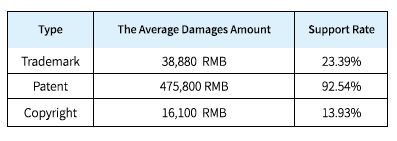In recent years, China has continuously strengthened intellectual property protection to optimize the legal business environment. In the practice of intellectual property infringement litigation, accurately determining the amount of damages has gradually become one of the focuses of the trial of infringement cases.
According to the author's search, the average awarded damages amount and support rate of Intellectual property civil litigations in China from Jan. 2022 to Dec. of 2022 are as follows:

It can be seen from the table that the support rate and average damages amount of Chinese courts for IPR (intellectual property right) holders' claim for damages in trademark and copyright infringement cases are not high. It is obvious that obtaining an award of high damages is one of goals of a IPR holder to initiate a civil litigation. The crucial task for achieving the goal is collect and utilize evidence, because the facts, which can be recognized by Chinese courts, are mainly those proven by evidence.
This article will introduce three categories of damages evidence, an overview of the calculation of damages for IPR infringement in China, as well as three steps and related practical advice for obtaining high damages from the perspective of evidence.
1. Three categories of damages Evidence
Article 31 of the Several Provisions on Evidence in Civil Litigation of Intellectual Property Rights in China, implemented by the Supreme People's Court of China on November 18, 2021, provides evidence that can be used to prove the amount of compensation for intellectual property infringement. The specified evidence can be classified into three categories, namely the evidence filed by an IPR holder, the evidence collected by applying for court investigation, the evidence filed by the alleged infringer.
1) The evidence filed by an IPR Holder
In practice, an IPR holder usually can submit damages evidence, which is not confidential or has been disclosed in earlier relevant proceedings involved by him. The non-confidential evidence may include annual reports of listed companies, prospectuses, advertisements on website or online e-commerce platforms, the alleged infringer's business income shown in public courts' judgements, profit margin evidence issued by relevant industry associations or government agencies, field investigation report, notarized evidence of purchase, etc. The earlier proceedings in which damages evidence may be disclosed to IPR holders may include oppositions or invalidations against the alleged infringer's IPR, or raid actions or criminal litigations against IPR infringement, etc.
2) The evidence collected by applying for court investigation
A considerable amount of damages evidence is controlled by parties other than an IPR holder and the IPR holder, based on his own ability, is not able to get access to them. According to relevant laws in China, IPR holders may actively apply for court investigation to collect the evidence on the grounds that the evidence is not able to be obtained by him or his lawyers for objective reasons. For instance, with a lawyer investigator order issued by a competent court, an IPR holder's agent can obtain the alleged infringed products transaction record from e-commerce platforms. Normally in computer software infringement lawsuits, with the assistance of a competent court, an IPR holder is able to conduct evidence preservation at the workplace of the alleged infringer.
3) The evidence filed by the alleged infringer
According to the principle of who claims and who proves, an IPR holder shall be liable for the accused infringer's infringement as well as damages. In most cases, the alleged infringer is unwilling to submit damages evidence.
In China, an IPR holder may utilize two ways to push the accused infringer to submit relevant damages evidence. First is to apply to the court for evidence disclosure. In the case of Baidu vs. Jingbaidu, the IPR holder applies to Beijing IP court for evidence disclosure of the alleged infringer's store property information, lease contract information of leased premises, sales revenue books, financial statements and tax information, on the grounds that the relevant evidence cannot be obtained by him for objective reasons and the evidence is likely to be lost or difficult to be obtained later. The said application is justified by the court and the accused infringer has to submit relevant materials. Fortunately, these materials are later used by the court as a reference for calculating damages. Second is to pursue a shift of the burden of proof. If an IPR holder has made every effort to prove the damages, the burden of proof has been shifted to the alleged infringer, who shall be liable for submitting damages evidence.
2. An overview of the calculation of damages for IPR infringement in China
In China, damages for IPR infringement can be calculated with reference to one of the following:
- Losses of the IPR holder;
- Profits of the infringer;
- A reasonable multiple of the IPR license fees, when it is difficult to determine losses of the IPR holder, profits of the infringer;
- Statutory damages of less than 5 million yuan, when it is difficult to determine losses of the IPR holder, profits of the infringer or IPR license fees;
- Punitive damages of one to five times of the base amount determined by losses of the IPR holder, profits of the infringer or IPR license fees, when the IPR infringement is committed intentionally with serious circumstance.
The first three can be called as "evidence proved damages".
In determining the amount of damages, a Chinese court will first check whether it can establish the losses of the IPR holder, profits of the infringer or IPR license fees by evidence on record. If so, the evidence proven damages will prevail. If so, and the IPR infringement is intentional and serious, punitive damages will apply. If it is difficult to determine losses of the IPR holder, profits of the infringer or IPR license fees, the statutory damages will apply.
In practice, over 90% civil IPR litigation in China uses statutory damages of less than 5 million yuan due to the difficulty of determining the IPR's losses, infringer's profits or IPR licensing fees.
3. Evidence needed to obtain high damages and related practical advice
First, in order to be awarded high damages, an IPR holder shall do every effort to assist court in determining losses of the IPR holder, profits of the infringers or IPR license fees.
1) Evidence determining losses of an IPR holder:
For trademark civil litigation, according to judicial interpretation, the losses of the IPR holder may be calculated according to the reduction in the sales of goods caused by the infringement or the sales volume of the infringing goods multiplied by the unit profit of the registered trademark goods.
For patent civil litigation, according to judicial interpretation, the losses of the IPR holder may be calculated according to the reduction in the sales of patented product caused by the infringement or the sales volume on the market of the infringing product multiplied by the reasonable unit profit of patented product.
For copyright civil litigation, according to judicial interpretation, the losses of the IPR holder may be calculated according to the reduction in the distribution of the copies caused by the infringement or the sales volume of the infringing copies multiplied by the unit profit of the right holder's distribution of the copies.
The application of the losses of IPR holder standard in calculating damages has been well illustrated in one Adidas trademark civil litigation in China. The court of second instance held that the losses of the IPR holder due to infringement is 6050 pairs x 189 yuan/pair x 50.4% gross profit margin x 60%=345,779.28 yuan. The sales volume (6050 pairs) of the infringing goods is based on the number of shoe uppers seized by the administrative authority in raid action. The unit profit of registered trademark goods is calculated according to 189 yuan (the lowest unit price of authentic shoes in the official flagship store of Adidas) multiplied by 50.4% (the gross profit margin of Adidas annual accounting report) and then multiplied by 60% (taking into account that the infringing products are not finished shoes, which cannot be directly used in the field of consumption). In said case, when determining losses of IPR holder, the court of second instance accepted the evidence include the statement made by the infringer when accepting the inquiry of the administrative authority, the prices of authentic shoes in the official flagship store of Adidas, Adidas annual accounting report, etc..
2) Evidence determining profits of the infringer:
For trademark civil litigation, according to judicial interpretation, profits of the infringer can be calculated according to the sales volume of infringing goods multiplied by the unit profit of the goods; If the unit profit of the goods cannot be ascertained, it shall be calculated according to the unit profit of the registered trademark goods.
For patent civil litigation, according to judicial interpretation, profits of the infringer can be calculated according to the sales volume of infringing goods on the market multiplied by the reasonable profit of each infringing product. The profit obtained by the infringer due to infringement are generally calculated according to the operating profit of the infringer. For the infringer who takes IPR infringement as its business, it can be calculated according to the sales profit.
For copyright civil litigation, there is no judicial interpretation to specify the profit calculation of the infringer. In judicial practice, it is mainly based on the evidence of the profit of the infringer submitted by the IPR holder or the alleged infringer, and the specific pattern of infringement is used to analyze the exclusive value contributed by the specific infringed work in the profit.
In the ERDOS vs. MIQI trademark civil litigation case, Beijing IP Court held that the profits of the infringer is 10446 pcs x 35 yuan/pcs x 25% profit margin=91,402.5 yuan. The sales amount (10446 pcs) of the infringing goods is shown in the infringer's Tmall online store. Unit price of the infringing goods is determined by the court as 35 yuan, while the court confirmed at its discretion that the original price and special price products accounted for 50% of the total sales respectively. Profit margin is determined by the court as 25%, while no evidence to support the 50% profit margin claimed by the plaintiff and the 20% profit margin admitted by the defendant in court.
3) IPR license fees
Where IPR requests a court to determine the amount of damages by reference to a reasonable multiple of IPR license fees, he shall submit sufficient evidence proving why the said IPR license fee can be referenced in the current case. For instance, the IPR license fees are actually paid, the licensee is not his interested party, and they meet the general standards for industry licensing.
In the OPPLE vs. Dong Sheng trademark civil litigation, Guangdong Superior Court held that the license fee authorized by OPPLE to distributor is 0.35 million yuan/year has reached the evidentiary standard of high probability and therefore is accepted. The evidence as filed include executed trademark license agreement, corresponding retail channel regional operator contract, shipment consignment note, bank transfer certificate and site photo of the authorized shop bearing OPPLE. We can see that a court in China usually requires an IPR holder to submit a relatively complete chain of evidence to show the fulfillment of the licensing transaction before determining the amount of damages by reference to a reasonable multiple of IPR license fees.
Secondly, in order to be awarded damages higher than specific amount proven by evidence, we may actively claim punitive damages.
The damages for IPR infringement generally follows the principle of compensation. For intentional infringement with serious circumstances, IPR holders can actively claim punitive damages. The punitive compensation system is not only to fill in the economic losses of IPR holders, but also to reflect the punishment for intentional infringers. The preconditions for applying punitive damages are 1) base amount can be determined, 2) the defendant intentionally infringes upon the IPR, and 3) the infringement has serious circumstances.
1) Base amount
In accordance with relevant laws, losses of the IPR holder, profits of the infringer or IPR license fee shall be taken as the base amount for calculating punitive damages. In the previous part of this article, we have discussed how to obtain relevant evidence for losses of the IPR holder, profits of the infringers or IPR license fee.
2) Evidence of intentional infringement
The Supreme People's Court of China has listed some specific circumstances wherein the defendant intentionally infringes upon the IPR:
- The defendant still commits the IPR infringement after being notified or warned by the plaintiff or party of interest.
- The defendant or its legal representative or manager is the legal representative, manager or actual controller of the plaintiff or party of interest.
- The defendant has work, labor, cooperation, licensing, distribution, agency, representation or any other relationship with the plaintiff or a party of interest, and has been in contact with the infringed IPR.
- The defendant has business relations with the plaintiff or party of interest or has any consultation with the plaintiff or party of interest for the purpose of reaching a contract, among others, and has been in contact with the infringed IPR.
- The defendant commits any act of piracy or counterfeiting any registered trademark.
- Any other circumstance that may be determined as an intentional act. From the above", intentional infringement" could be interpreted that the infringer is aware of others' IPR through being notified or warned, or through the relationship with IPR holder or a party of interest, etc., but still commits the infringement act. Therefore, the relevant" intentional infringement" evidence shall focus on those which can prove how the infringer is aware of other's IPR.
3) Evidence that the infringement has serious circumstances
The Supreme People's Court of China has also listed some specific circumstance wherein the defendant's infringement has serious circumstances:
- The defendant commits the same or similar infringement after it has been subject to any administrative punishment or has assumed liability based on the ruling of the court due to infringement.
- The defendant takes IPR infringement as its business.
- The defendant forges, destroys or conceals any evidence of infringement.
- The defendant refuses to perform a preservation ruling.
- The defendant obtains huge benefits from the infringement or causes huge loss to the right holder due to the infringement.
- The infringement may endanger national security, public interest or personal health.
- Any other circumstance that may be determined as a serious circumstance. "Serious circumstances" could be understood that serious damages or endangerment caused by the infringement to IPR holder, competition order, judicial order, national security, public interest or personal health, etc. It would be easy to understand how to obtain the evidence proving the above (1) and (3)-(6). As for the above (2)" take IPR infringement as its business", the judicial practice in China shows that the typical situation would be that the infringing goods are the infringer's sole business or occupy a major proportion in the infringer's business.
Thirdly, if specific amount of damages cannot be proven by evidence, how we can obtain high damages in statutory damages issued by Chinese courts.
As mentioned above, evidence proved damages are always higher than the amount of the statutory damages. But, the statutory damages are applied by Chinese Courts in most cases. If specific amount of damages cannot be proven by evidence, how we can obtain high damages in statutory damages issued by Chinese courts. In principle, Chinese Courts shall consider the nature, duration and consequences of the infringement, the goodwill of IPR, the amount of IPR license fee, the type, time and scope of the IPR license, the subjective fault of the infringer and the reasonable expenses to stop the infringement, when determining the amount of damages. In practice, we need to 1) collect and submit as much evidence as possible reflecting the above consideration factors; 2) submit different types and sources of evidence for the same facts that need to be proven; 3) actively apply for court investigation or evidence preservation, if the evidence cannot be collected by an IPR holder; 4) submit evidence, even though which does not form a chain of evidence or is flawed, as it can prompt the responsible judge to make a high award from his free mind perspective.
In short, the damages for intellectual property infringement is not only a legal issue but also an economic issue. The IPR holder needs to try to prove the amount of damages for infringement from multiple angles, form a full chain of evidence, restore the objective truth related to the amount of damages as much as possible, and provide ideas and paths for the fine judgment of the amount of damages, so as to more effectively safeguard its own legitimate rights and interests.
To view the full newsletter please click here.
The content of this article is intended to provide a general guide to the subject matter. Specialist advice should be sought about your specific circumstances.

